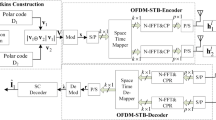Abstract
Coded-cooperation combines virtual MIMO transmission and channel coding to achieve forward error correction while achieving diversity gain. It is a promising technology in 5G communications. The polar code is the only channel coding technology that can theoretically achieve Shannon limit transmission, which make it the preferred coding technology in cooperative communication. In this paper, we proposed a new wireless communication scheme, which is a polar coded cooperative spatial modulation schemes based on Plotkin construction and Quasi-uniform puncturing (QUP). First, we adopt Plotkin construction based on the inverted codeword of the polar code to get a cooperation method, which offer a significant improvement in performance on the polar code cooperation under fading channels. We analyze the decoding characteristics of the inverted codewords and then introduces the QUP method to improve the cooperation benefits. At the same time, we extend the cooperation scheme with differential spatial modulation for the proposed coded cooperative schemes. The new coded-cooperation scheme outperforms its coded non-cooperative counterpart schemes under identical conditions, as expected. Monte Carlo simulated results show that the proposed cooperative schemes outperform their corresponding non-cooperative counterpart schemes, by the gain of 2.5 dB with 1024 code length and 0.25 code rate under identical conditions.







Similar content being viewed by others
Data Availability
The datasets analysed during the current study are available from the corresponding author on reasonable request.
Code Availability
The code will made be available on reasonable request.
References
Nosratinia, A., Hunter, T. E., & Hedayat, A. (2004). Cooperative communication in wireless networks. IEEE Communications Magazine, 42(10), 74–80.
Hunter, T. E., & Nosratinia, A. (2006). Diversity through coded cooperation. IEEE Transaction. wireless. communication, 5(2), 283–289.
Vucetic, B. (2002). Turbo Codes Principles and Applications. IEEE Circuits & Devices Magazine, 18(1), 30–31.
Ben Chikha, H., Chaoui, S., Dayoub, I., et al. (2012). A parallel concatenated convolutional-based distributed coded cooperation scheme for relay channels. Wireless Personal Communications, 67, 951–969.
Bian, Y., Cheng, X., Wen, M., et al. (2015). Differential spatial modulation [J]. IEEE Transactions on Vehicular Technology, 2015, 64(7), 3262–3268.
Xiao, L., Xiao, Y., Yang, P., et al. (2017). Space-time block coded differential spatial modulation. IEEE Transactions on Vehicular Technology, 66(10), 8821–8834.
Li, J., Wen, M., Cheng, X., et al. (2016). Differential spatial modulation with gray coded antenna activation order. IEEE Communications Letters, 20(6), 1100–1103.
Yu, D., Yue, G., Liu, A., et al. (2020). Absolute amplitude differential phase spatial modulation and its non-coherent detection under fast fading channels. IEEE Transactions on Wireless Communications., 19(4), 2742–2755.
Arikan, E. (2009). Channel polarization: A method for constructing capacity-achieving codes for symmetric binary-input memoryless channels. IEEE Transactions on Information Theory, 55(7), 3051–3073.
Arikan, E. (2011). Systematic polar coding. IEEE Communications Letters, 15(8), 860–862.
Ejaz, S., Yang, F., Soliman, T. H., et al. (2015). Network polar coded cooperation with joint SC decoding. Electronics Letters, 51(9), 695–697.
Mughal, S., Yang, F., Xu, H., et al. (2019). Coded cooperative spatial modulation based on multi-level construction of polar code. Telecommunication Systems, 70, 435–446.
Wang, X., Cao, C., Sun, C., et al. (2020). Nested construction of polar codes for blind detection [J]. IEEE Wireless Communication Letters, 2020, PP(99), 1–1.
Liang, H., Liu, A., Liu, X., et al. (2020). Construction and optimization for adaptive polar coded cooperation. IEEE Wireless Communications Letters, 9(8), 1187–1190.
Liang, H., Liu, A., Dai, J., et al. (2021). Design and analysis of polar coded cooperation with incremental redundancy for IoT in fading channels. IET Communications, 15(4), 595–602.
Miloslavskaya, V. (2015). Shortened polar codes. IEEE Transactions on Information Theory, 61(9), 4852–4865.
Zhang, L., Zhang, Z., Wang, X., Yu, Q., & Chen, Y. (2014). On the puncturing patterns for punctured polar codes. IEEE International Symposium on Information Theory, 2014, 121–125. https://doi.org/10.1109/ISIT.2014.6874807
Shin, D. M., Lim, S. C., & Yang, K. (2013). Design of length-compatible polar codes based on the reduction of polarizing matrices. IEEE Transactions on Communications, 61(7), 2593–2599.
Zhao, K., Liu, Y., Du, H., et al. (2019). Performance analysis of bit-interleaved polar coded modulation. Wireless Personal Communications, 109, 1285–1309.
Tseng, S. M., Hsu, W. C., & Tseng, D. F. (2022). Deep learning based decoding for polar codes in Markov Gaussian memory impulse noise channels. Wireless Personal Communications, 122, 737–753.
Fayyaz, U., & Barry, J. R. (2014). Low-complexity soft-output decoding of polar codes. IEEE Journal on Selected Areas in Communications, 32(5), 958–966.
Plotkin, M. (1960). Binary codes with specified minimum distance. IRE Transactions on Information Theory, 6(4), 445–450.
Funding
This work is supported by the Beibu Gulf University Foundation project(2017KYQD124) from Guangxi Province, China.
Author information
Authors and Affiliations
Corresponding author
Ethics declarations
Conflict of interest
The authors declare that there is no conflicts of interest regarding the publication of this article.
Additional information
Publisher's Note
Springer Nature remains neutral with regard to jurisdictional claims in published maps and institutional affiliations.
Rights and permissions
Springer Nature or its licensor (e.g. a society or other partner) holds exclusive rights to this article under a publishing agreement with the author(s) or other rightsholder(s); author self-archiving of the accepted manuscript version of this article is solely governed by the terms of such publishing agreement and applicable law.
About this article
Cite this article
Zeng, J., Lu, W. Polar Coded Cooperative Differential Spatial Modulation Based on Plotkin Construction and Quasi-Uniform Puncturing. Wireless Pers Commun 129, 1407–1423 (2023). https://doi.org/10.1007/s11277-023-10196-8
Accepted:
Published:
Issue Date:
DOI: https://doi.org/10.1007/s11277-023-10196-8




